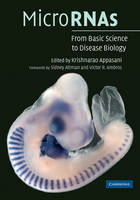
MicroRNAs
Cambridge University Press (Verlag)
978-0-521-11855-2 (ISBN)
MicroRNAs (miRNAs) are RNA molecules, conserved by evolution, that regulate gene expressions and their discovery has revolutionised both basic biomedical research and drug discovery. Expression levels of miRNAs have been found to vary between tissues and with developmental stages and hence evaluation of the global expression of miRNAs potentially provides opportunities to identify regulatory points for many different biological processes. This wide-ranging reference work, written by leading experts from both academia and industry, will be an invaluable resource for all those wishing to use miRNA techniques in their own research, from graduate students, post-docs and researchers in academia to those working in R&D in biotechnology and pharmaceutical companies who need to understand this emerging technology. From the discovery of miRNAs and their functions to their detection and role in disease biology, this volume uniquely integrates the basic science with industry application towards drug validation, diagnostic and therapeutic development.
Krishnarao Appasani is the Founder and Chief Executive Officer of Gene Expression Systems, a gene discovery company, focusing on functional genomics in cancer research. He is the Editor of RNA Interference: From Basic Science to Drug Development (2005).
Foreword; Foreword; Introduction Part I. Discovery of MicroRNAs in Various Organisms: 1. The microRNAs of C. elegans; 2. Non-coding RNAs - development of man-made vector-based intronic microRNAs; 3. Seeing is believing: strategies for studying microRNA expression; 4. MicroRNAs in limb development; 5. Identification of miRNAs in plant oryza sativa; Part II. MicroRNA Functions and RNAi-Mediated Pathways: 6. Inhibition of translation initiation by a microRNA; 7. In situ analysis of microRNA expression during vertebrate development; 8. MicroRNA function in the nervous system; 9. Micro RNA expression that controls the amount of branched chain α-ketoacid dehydrogenase in mitochondria of human cells; 10. MicroRNAs and the regulation of leaf shape; Part III. Computational Biology of MicroRNAs: 11. MiRBase: a database of microRNA sequences, targets and nomenclature; 12. Computational prediction of microRNA targets in vertebrates, fruitflies and nematodes; 13. Computational approaches to elucidate miRNA biology; 14. The RNA hybrid approach to microRNA target prediction; 15. Machine learning predicts microRNA target sites; 16. Models of microRNA-target coordination; Part IV. Detection and Quantitation of MicroRNAs: 17. Detection and analysis of microRNAs using LNA (locked nucleic acid)-modified probes; 18. Detection and quantitation of microRNAs using the RNA Invader® assay; 19. A single molecule method to quantify miRNA gene expression; 20. Real-time quantification of MicroRNAs by TaqMan® assays; 21. Real-time quantification of miRNAs and mRNAs employing universal reverse transcription; Part V. MicroRNAs in Disease Biology: 22. Dysregulation of microRNAs in human malignancy; 23. High throughput microRNAs profiling in cancers; 24. Roles of microRNAs in cancer and development; 25. MiR-122 in mammalian liver; 26. MiRNAs in glioblastoma; 27. Role of microRNA pathway in Fragile X mental retardation; 28. Insertion of miRNA125b-1 into immunoglobulin heavy chain gene locus mediated by V(D)J recombination in precursor B cell acute lymphoblastic leukemia; 29. MiRNAs in TPA-induced differentiation of HL-60 cells; 30. MiRNAs in skeletal muscle differentiation; 31. Identification and potential function of viral microRNAs; 32. Lost in translation: regulation of HIV-1 by microRNAs and a key enzyme of RNA-directed RNA polymerase; Part VI. MicroRNAs in Stem Cell Development: 33. MicroRNAs in the stem cells of the mouse Blastocyst; 34. The role of miRNA in hematopoiesis; 35. MicroRNAs in embryonic stem cell differentiation and prediction of their targets; 36. Generation of single cell microRNA expression profile.
| Erscheint lt. Verlag | 20.8.2009 |
|---|---|
| Vorwort | Sidney Altman, Victor R. Ambros |
| Verlagsort | Cambridge |
| Sprache | englisch |
| Maße | 178 x 254 mm |
| Gewicht | 990 g |
| Themenwelt | Medizin / Pharmazie ► Medizinische Fachgebiete ► Pharmakologie / Pharmakotherapie |
| Studium ► 2. Studienabschnitt (Klinik) ► Humangenetik | |
| Technik ► Umwelttechnik / Biotechnologie | |
| ISBN-10 | 0-521-11855-7 / 0521118557 |
| ISBN-13 | 978-0-521-11855-2 / 9780521118552 |
| Zustand | Neuware |
| Haben Sie eine Frage zum Produkt? |
aus dem Bereich


